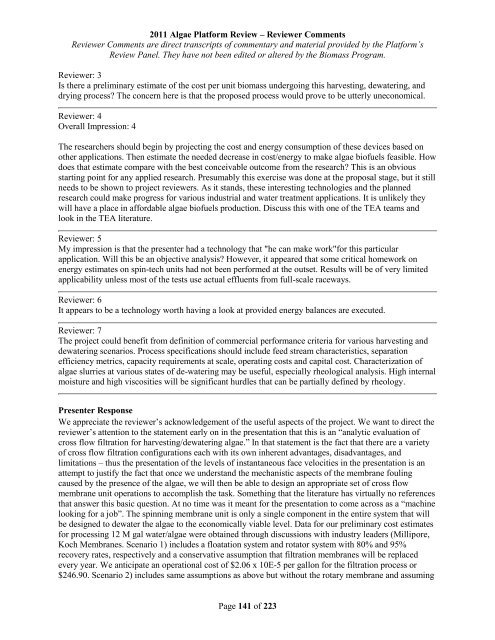Reviewer Comments - EERE
Reviewer Comments - EERE
Reviewer Comments - EERE
You also want an ePaper? Increase the reach of your titles
YUMPU automatically turns print PDFs into web optimized ePapers that Google loves.
2011 Algae Platform Review – <strong>Reviewer</strong> <strong>Comments</strong><br />
<strong>Reviewer</strong> <strong>Comments</strong> are direct transcripts of commentary and material provided by the Platform’s<br />
Review Panel. They have not been edited or altered by the Biomass Program.<br />
<strong>Reviewer</strong>: 3<br />
Is there a preliminary estimate of the cost per unit biomass undergoing this harvesting, dewatering, and<br />
drying process? The concern here is that the proposed process would prove to be utterly uneconomical.<br />
<strong>Reviewer</strong>: 4<br />
Overall Impression: 4<br />
The researchers should begin by projecting the cost and energy consumption of these devices based on<br />
other applications. Then estimate the needed decrease in cost/energy to make algae biofuels feasible. How<br />
does that estimate compare with the best conceivable outcome from the research? This is an obvious<br />
starting point for any applied research. Presumably this exercise was done at the proposal stage, but it still<br />
needs to be shown to project reviewers. As it stands, these interesting technologies and the planned<br />
research could make progress for various industrial and water treatment applications. It is unlikely they<br />
will have a place in affordable algae biofuels production. Discuss this with one of the TEA teams and<br />
look in the TEA literature.<br />
<strong>Reviewer</strong>: 5<br />
My impression is that the presenter had a technology that "he can make work"for this particular<br />
application. Will this be an objective analysis? However, it appeared that some critical homework on<br />
energy estimates on spin-tech units had not been performed at the outset. Results will be of very limited<br />
applicability unless most of the tests use actual effluents from full-scale raceways.<br />
<strong>Reviewer</strong>: 6<br />
It appears to be a technology worth having a look at provided energy balances are executed.<br />
<strong>Reviewer</strong>: 7<br />
The project could benefit from definition of commercial performance criteria for various harvesting and<br />
dewatering scenarios. Process specifications should include feed stream characteristics, separation<br />
efficiency metrics, capacity requirements at scale, operating costs and capital cost. Characterization of<br />
algae slurries at various states of de-watering may be useful, especially rheological analysis. High internal<br />
moisture and high viscosities will be significant hurdles that can be partially defined by rheology.<br />
Presenter Response<br />
We appreciate the reviewer’s acknowledgement of the useful aspects of the project. We want to direct the<br />
reviewer’s attention to the statement early on in the presentation that this is an “analytic evaluation of<br />
cross flow filtration for harvesting/dewatering algae.” In that statement is the fact that there are a variety<br />
of cross flow filtration configurations each with its own inherent advantages, disadvantages, and<br />
limitations – thus the presentation of the levels of instantaneous face velocities in the presentation is an<br />
attempt to justify the fact that once we understand the mechanistic aspects of the membrane fouling<br />
caused by the presence of the algae, we will then be able to design an appropriate set of cross flow<br />
membrane unit operations to accomplish the task. Something that the literature has virtually no references<br />
that answer this basic question. At no time was it meant for the presentation to come across as a “machine<br />
looking for a job”. The spinning membrane unit is only a single component in the entire system that will<br />
be designed to dewater the algae to the economically viable level. Data for our preliminary cost estimates<br />
for processing 12 M gal water/algae were obtained through discussions with industry leaders (Millipore,<br />
Koch Membranes. Scenario 1) includes a floatation system and rotator system with 80% and 95%<br />
recovery rates, respectively and a conservative assumption that filtration membranes will be replaced<br />
every year. We anticipate an operational cost of $2.06 x 10E-5 per gallon for the filtration process or<br />
$246.90. Scenario 2) includes same assumptions as above but without the rotary membrane and assuming<br />
Page 141 of 223




